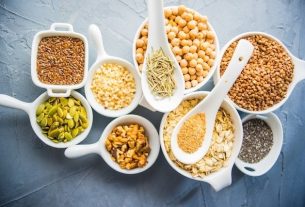Carbohydrates are molecules made up of carbon, hydrogen and oxygen, whose function is to provide energy to maintain the body’s vital functions, such as breathing and heartbeat, and for everyday activities, such as working and exercising.
According to their structure, carbohydrates, which are also known as carbohydrates, glycides or saccharides, are classified into simple and complex, directly influencing the absorption of this nutrient by the body.
It is recommended to prioritize complex carbohydrates in the diet, as they are absorbed more slowly, balancing blood glucose levels. Simple carbohydrates should be consumed in moderation, as they have a higher glycemic index, altering blood sugar.

Types of carbohydrates
Carbohydrates can be classified according to their complexity into simple and complex.
1. Simple carbohydrates
Simple carbohydrates are simple molecules that form larger structures and complex carbohydrates such as glucose, ribose, xylose, galactose and fructose.
When you eat a portion of carbohydrate, such as bread or fruit, for example, it breaks down in the gastrointestinal system, reaching the intestine in the form of monosaccharides to be absorbed.
The union of two monosaccharide units forms disaccharides, such as sucrose or table sugar (glucose + fructose), lactose (galactose + glucose) and maltose (glucose + glucose).
The union of 3 to 10 monosaccharide units gives rise to oligosaccharides, which are molecules with probiotic action such as fructooligosaccharides (FOS) and galactooligosaccharides (GOS).
Because they are more easily digested and absorbed by the body, carbohydrates cause blood sugar to rise quickly, that is, they have a high glycemic index. Furthermore, this type of carbohydrate also increases the feeling of hunger and, when consumed in excess, favors the accumulation of body fat and weight gain. See more about the glycemic index of foods.
Where to find: white sugar, brown sugar, demerara sugar, honey, maple syrup, high fructose corn syrup, milk, fruit and soft drinks.
2. Complex carbohydrates
Complex carbohydrates, or polysaccharides, are those that contain more than 10 monosaccharide units, forming complex structures. Some examples are starch and glycogen, which are stored in the liver and muscles, and cellulose.
Within complex carbohydrates are fibers, such as cellulose, fructooligosaccharides (FOS) and lignin, which are components of vegetables that are not digested by gastric enzymes, slowing digestion, promoting the feeling of satiety and stimulating natural bowel movements.
Where to find: rice, bread, pasta, cassava, potatoes, wheat and corn flour. The carbohydrates that have the highest fiber content are: brown rice, whole grain bread, oats, legumes, vegetables and fruits.
What are worth for
The main functions of carbohydrates for health are:
1. Produce energy
Carbohydrates are the body’s main source of energy, as glucose is generated during their digestion by the gastrointestinal tract. The body needs an average of 160 g of glucose to function properly, which is the preferred fuel for the body’s cells.
When glucose is absorbed in the intestine, much of it is broken down to produce adenosine triphosphate (ATP), an energy molecule that is essential for several metabolic processes in the body.
2. Provide energy to the brain
Glucose produced from the digestion of simple and complex carbohydrates is mainly used by the brain to maintain its vital functions. The brain uses around 120 g of carbohydrates per day, which is the main source of energy for this organ.
3. Store energy
Part of the glucose absorbed in the intestine is stored in the form of glycogen in the liver and another part is also deposited in the muscles, to be used in “emergency” situations, such as prolonged fasting, long periods of high-intensity exercise, alertness or of diseases, for example.
4. Preserve muscles
Carbohydrates are important for preserving muscles, as a lack of glucose causes loss of muscle mass. This happens because in the absence of glucose in the body, it can be obtained through the muscles, which are broken down into amino acids and converted into glucose.
5. Improve digestive health
Fiber is a type of carbohydrate that is not digested and does not produce glucose, but is essential for digestive health, as it promotes healthy intestinal flora, regulates blood glucose levels and stimulates bowel movements, preventing problems such as constipation. constipation, diarrhea and diabetes. Learn more about the benefits of fiber for the body.
Recommended quantity
The generally recommended amount of carbohydrates per day is 50 to 60% of the total caloric value of the diet. A person on a diet of 1800 calories per day should consume between 225 and 270 g of carbohydrates per day, for example.
However, the recommended amount of carbohydrates also varies according to the person’s weight, age, sex, physical activity and health status.
The daily fiber recommendation is 26g for children aged 9 to 18 and 25g per day for adults aged 19 to 50. Check the amount of fiber indicated for each age.
Carbohydrate metabolism can happen in several ways, including:
- Glycolysis: it is a process that breaks down glucose into ATP and pyruvate, molecules that are used in the body to produce energy;
- Glycogenesis: It is a process in which glycogen is produced to be stored in the liver and, in smaller quantities, in the muscles. This process happens after eating foods rich in carbohydrates;
- Gluconeogenesis: In this metabolic pathway, glucose is produced from sources other than carbohydrates, such as glycerol, fatty acids, amino acids or lactate. This pathway is activated when the body goes through a period of prolonged fasting;
- Glycogenolysis: is a process in which glycogen stored in the liver and/or muscles is broken down to form glucose. This pathway is activated when the body requires an increase in blood glucose.
These metabolic pathways are activated according to the body’s needs and the situation in which it finds itself.

Sign up for our newsletter and stay up to date with exclusive news
that can transform your routine!
Warning: Undefined array key "title" in /home/storelat/public_html/wp-content/plugins/link-whisper-premium/templates/frontend/related-posts.php on line 12
Warning: Undefined array key "title_tag" in /home/storelat/public_html/wp-content/plugins/link-whisper-premium/templates/frontend/related-posts.php on line 13



